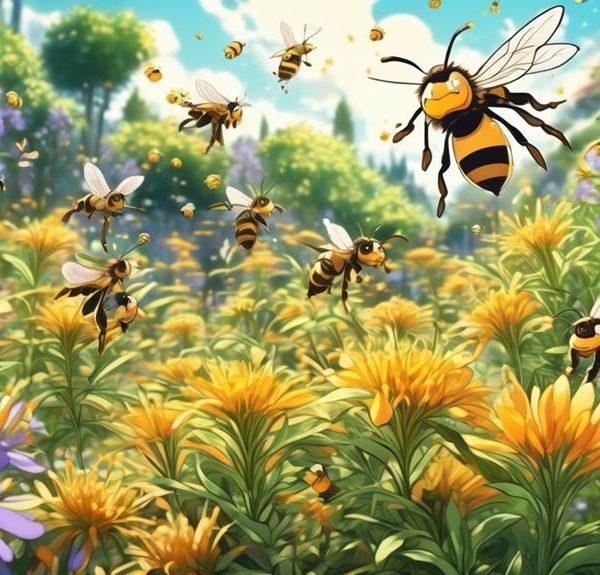An intriguing exploration into whether bees favor delphiniums, uncovering secrets to enhance your garden's ecosystem.
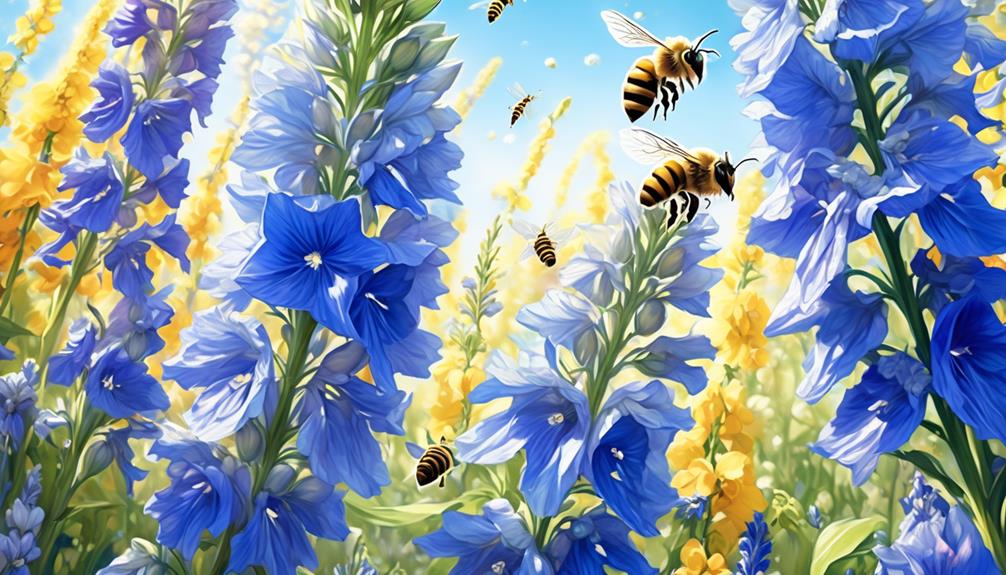
Do Bees Like Delphinium?
Imagine standing in your garden on a bright summer day, the air vibrating with the gentle hum of bees as they flit from flower to flower, their tiny legs dusted with pollen. You've noticed that these industrious creatures seem particularly attracted to your delphiniums, their vibrant petals a beacon in the morning light.
But do bees actually prefer delphiniums, or is it merely a coincidence? As a gardener or nature enthusiast, you're likely curious about the intricacies of this apparent bond.
We're about to explore this fascinating relationship, and perhaps the insights gained might transform the way you view your garden's ecosystem.
Key Takeaways
- Delphiniums attract bees with their vibrant colors, particularly blue and purple.
- Bees are drawn to flowers with a single layer of petals, like Delphiniums.
- The fragrance emitted by Delphiniums is enticing to bees.
- Delphiniums play a crucial role in bee pollination, providing a rich source of nectar and pollen.
Understanding the Delphinium Plant
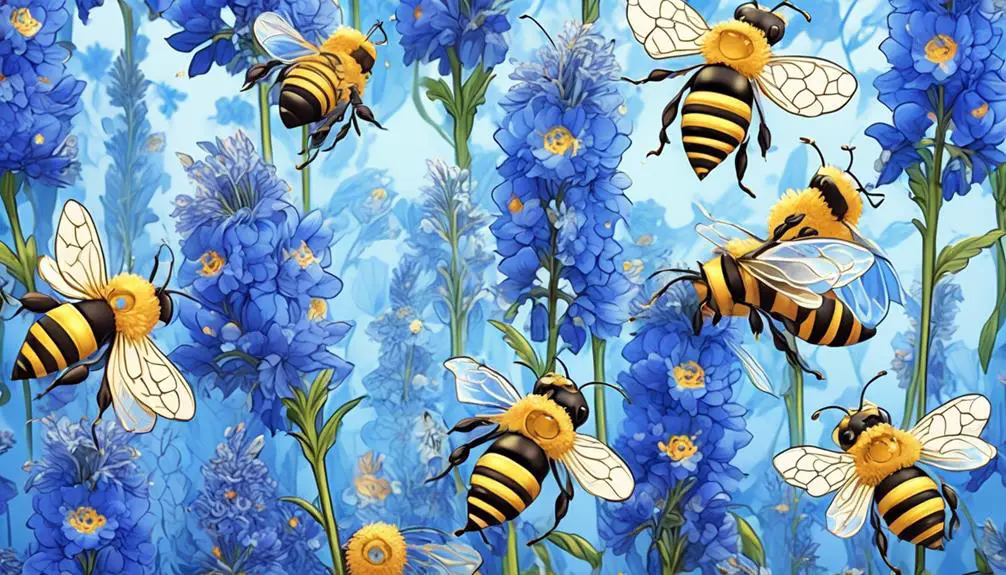
The Delphinium plant, a vibrant tower of petals often gracing garden landscapes, demands your understanding for successful cultivation and attraction of bees. Belonging to the Ranunculaceae family, this perennial plant is comprised of nearly 300 species, offering a diverse range of colors from blue and purple to white and pink.
You've got to pay attention to its unique characteristics. Delphiniums are sun-loving plants, requiring at least six hours of direct sunlight daily. They need well-drained soil with a pH ranging between 6.0 and 7.0.
Watering is imperative for their survival, but you can't overdo it. Too much water can lead to root rot, while too little can cause wilting.
Remember, they're heavy feeders, so they'll require regular fertilization – a slow-release, balanced fertilizer is ideal.
You should be aware of their susceptibility to powdery mildew and other fungal diseases. Regular inspections, proper spacing for airflow, and appropriate fungicides are preventive measures you can take.
Understanding these aspects of Delphinium's biology won't only ensure successful cultivation but also make your garden a favorite amongst bees.
Bees and Their Flower Preferences

While successfully cultivating Delphiniums in your garden can create a colorful haven for bees, it's crucial to understand these buzzing pollinators and their flower preferences to build an even more diverse, bee-friendly environment. Bees aren't indiscriminate in their flower choices; they're attracted to specific colors, shapes, and scents.
In general, bees prefer flowers that are blue, purple, or yellow. They're particularly drawn to plants with a single layer of petals, such as Delphiniums, because they provide easy access to nectar and pollen. Flowers that release a sweet fragrance are also attractive to bees, as they use their olfactory senses to locate food sources.
However, different bee species have different preferences. For instance, Bumblebees prefer flowers with a landing platform, like the flat-faced Delphinium, while Honey bees gravitate towards plants with small, clustered flowers from which they can collect pollen efficiently.
Delphinium's Role in Bee Pollination

Boasting vibrant hues and a single layer of petals, Delphiniums play a pivotal role in bee pollination by acting as a rich, easily accessible source of nectar and pollen. The unique structure of Delphinium flowers facilitates bee visits. Their tall, sturdy stems allow for easy landing and support, while the petal's arrangement forms a sort of 'nectar guide' leading bees directly to the flower's center.
Delphiniums emit a strong fragrance, irresistible to bees, luring them from quite a distance. The pollen produced is sticky, adhering easily to bee bodies and increasing the efficiency of pollination when bees visit the next flower. Moreover, Delphiniums are prolific bloomers, ensuring a constant food supply for bees throughout their flowering season.
You must also consider the color spectrum. Bees perceive the world differently than humans; they see in ultraviolet. Delphiniums, particularly those of blue and purple hues, are highly attractive to bees as these colors stand out most in their vision.
In essence, Delphiniums are more than just a pretty face in your garden. They're an integral part of the ecosystem, facilitating bee pollination, and consequently, supporting a healthy environment.
Factors Affecting Bee Attraction
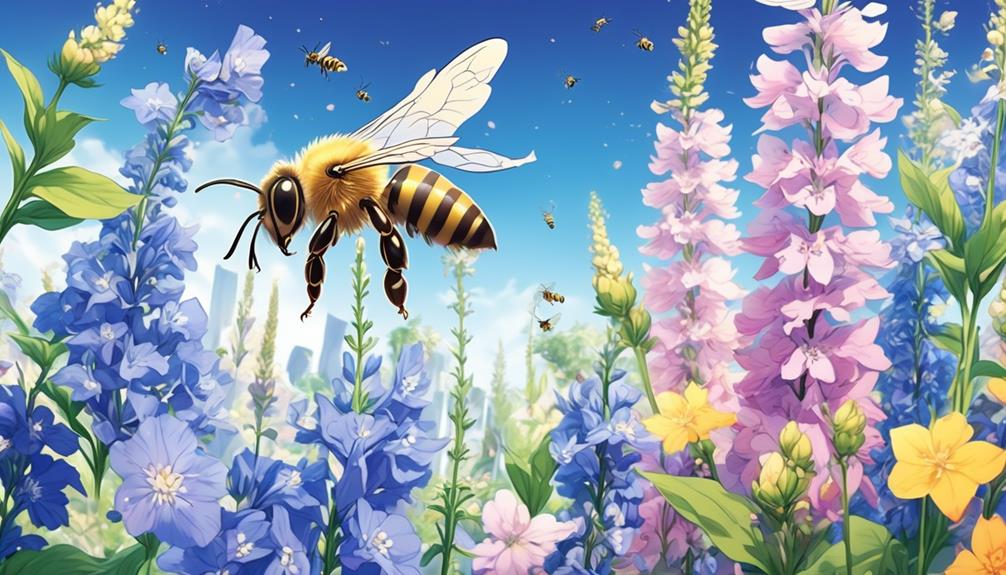
In your quest to attract more bees to your garden, understanding the factors that influence their attraction to certain plants, such as Delphiniums, is crucial. Bees aren't random in their choice of flowers; it's a calculated decision influenced by several factors.
Firstly, color plays a significant role in bee attraction. Bees tend to favor bright colors like blue, purple, and yellow, which Delphiniums abundantly display.
Secondly, the scent of a flower can draw bees in. Certain fragrances are more appealing to bees, and Delphiniums emit a pleasing aroma that's irresistible to them.
Thirdly, the shape and structure of the flower matter. Bees prefer flowers with flat or shallow blossoms that make it easy for them to access nectar and pollen, which Delphiniums provide.
Lastly, the presence of nectar guides, visual signals that guide bees to the flower's nectar, also affects bee attraction. Delphiniums, with their distinct nectar guides, are quite attractive to bees.
Understanding these factors doesn't just help in attracting more bees; it's also beneficial in designing a bee-friendly garden. You'll be able to choose the right combination of plants that won't only beautify your garden but also create a conducive environment for bees.
Bees' Impact on Delphinium Growth
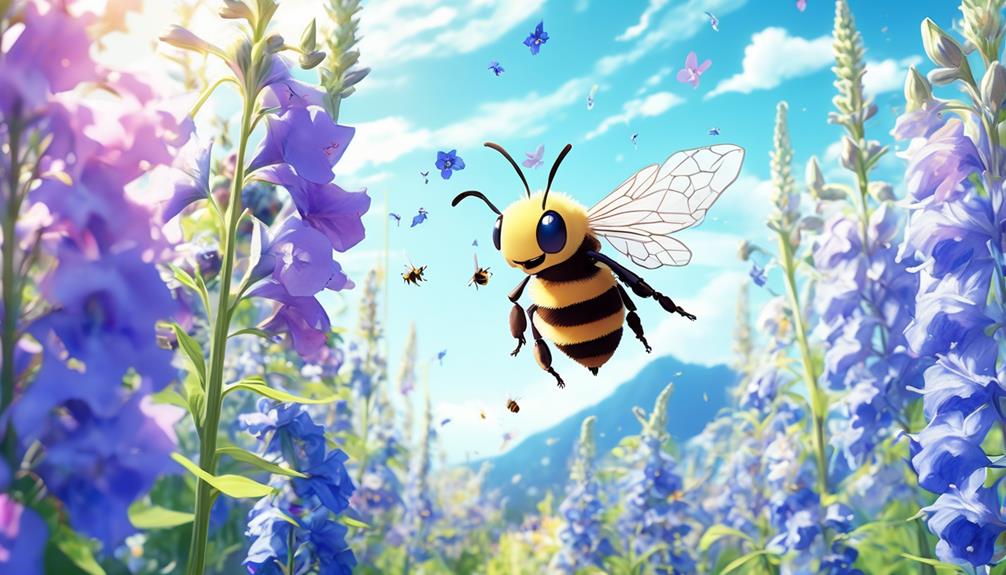
Ever wondered how bees affect the growth of your Delphiniums? Well, you're about to find out.
Bees play a crucial role in the development of Delphinium plants. The relationship between these insects and your garden's flora runs deep. Bees, as primary pollinators, facilitate the transfer of pollen from the male stamen to the female pistil of the Delphinium flower. This pollination process is vital for fertilization and subsequent seed production.
However, it's not just about seed production. The quality of your Delphiniums' growth also hinges on bee activity. Studies have shown that bee-pollinated plants often produce larger, healthier seeds. These seeds, in turn, germinate into robust plants with stronger resistance to disease and environmental stressors.
So, if you notice a drop in the bee population in your garden, it might impact your Delphiniums' growth negatively. You might see fewer flowers, smaller plants, and overall, less vibrant garden scenery.
In a nutshell, bees aren't just visitors to your garden; they're essential co-workers, tirelessly contributing to your Delphiniums' growth and overall garden health. So, let's appreciate these little pollinators and consider ways to make our gardens more bee-friendly.
Practical Tips for Bee-Friendly Gardening
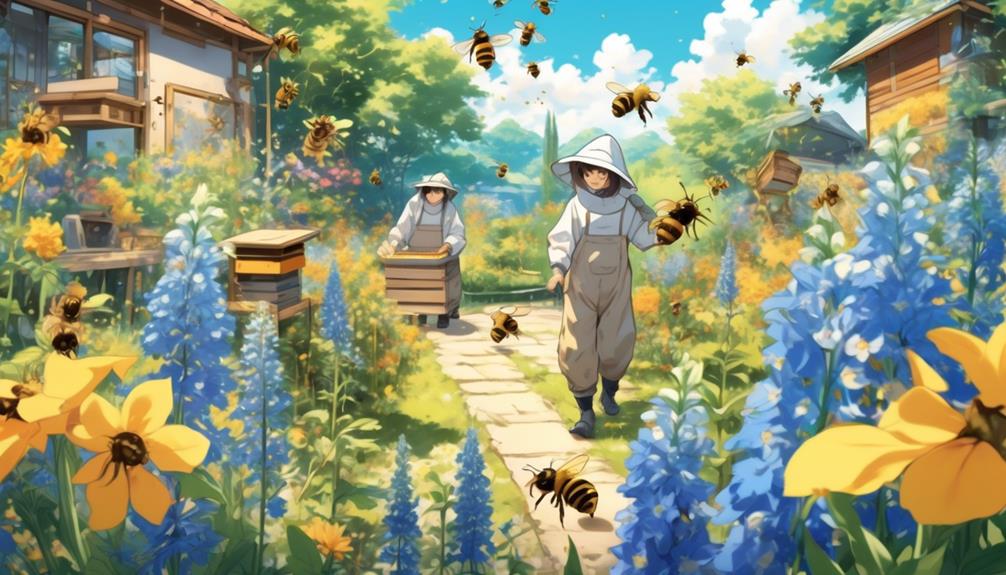
To foster a bee-friendly garden that benefits your Delphiniums, you'll need to implement certain strategies that create an inviting environment for these essential pollinators. Firstly, plant a variety of flowers that bloom at different times of the year to provide a continuous food source. Secondly, avoid using pesticides which can harm bees. Instead, opt for organic gardening methods.
Consider these key factors:
Factor | Description |
|---|---|
Plant Variety | Diversify plants to ensure year-round blossoms |
Pesticide Use | Avoid chemicals harmful to bees |
Water Source | Provide fresh water for bees |
Habitat | Leave some ground undisturbed for nesting bees |
Providing a fresh water source can attract bees, just be sure to provide landing spots so they don't drown. Lastly, bees need a place to nest. Many species burrow into the ground, so leaving some areas undisturbed can provide essential habitat.
Frequently Asked Questions
Can Bees Distinguish the Color of Delphinium Flowers?
Yes, bees can distinguish the color of delphinium flowers. Bees' eyes are more sensitive to the blue and ultraviolet end of the light spectrum.
Delphiniums, being blue or purple, are highly attractive to bees. They've evolved to be more visible to bees, who can see and are drawn to these colors more than others.
Do Other Insects Besides Bees Also Get Attracted to Delphinium?
Yes, other insects besides bees are also attracted to delphinium. This flowering plant doesn't just appeal to bees; it's also a magnet for butterflies and hummingbirds.
However, it's not only the vibrant colors that draw them in, but the nectar as well. Still, it's important to note that the attraction level might vary, as some insects may prefer other plants over delphinium.
How Does the Presence of Bees Affect Other Plants in the Vicinity of Delphinium?
When bees visit delphiniums, they don't just benefit these flowers. You see, bees carry pollen from plant to plant, aiding in cross-pollination. This process promotes genetic diversity among plants.
So, if there are other plants near your delphiniums, they're likely getting a helping hand from those busy bees too. This bee activity can lead to healthier, more robust plant populations in your garden.
What Type of Bees Are Most Likely to Pollinate Delphinium Plants?
You're most likely to see bumblebees pollinating delphinium plants. They're ideally suited for this task due to their size, strength, and their long tongues which can access nectar deep within the flowers.
Honeybees and solitary bees also visit delphiniums, but less frequently. It's worth noting that bees' preference can vary based on factors such as availability of other flowers, and specific bee species present in the area.
Are There Any Specific Geographical Regions Where Bees Are More Attracted to Delphinium?
Yes, bees' attraction to delphinium can vary based on geographical regions. In temperate areas, where delphiniums thrive, you'll often find bees buzzing around them.
Areas with cold winters and hot summers attract bees to these flowers due to their long blooming period.
However, in regions where delphiniums aren't native or common, bees may show less interest.
It's the mix of climate, flower availability, and bee species that determines their attraction.
Conclusion
In conclusion, bees absolutely adore delphinium! Their vibrant colours and sweet nectar make them irresistible to these industrious insects. However, other factors such as the plant's health and surrounding environment play a role in attracting bees.
Their pollination significantly boosts delphinium growth. By incorporating bee-friendly practices in your garden, you're not just helping these vital pollinators, but you're also ensuring your delphinium blooms beautifully.

